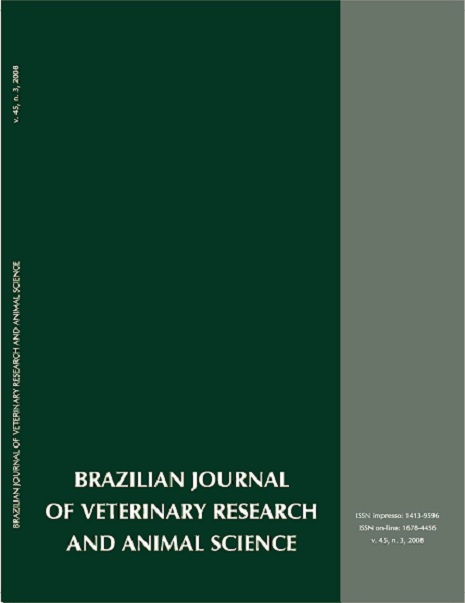Epidemiological aspects in leptospirosis: Research of anti-Leptospira spp antibodies, isolation and biomolecular research in bovines, rodents and workers in rural properties from Botucatu, SP, Brazil
DOI:
https://doi.org/10.11606/issn.1678-4456.bjvras.2008.26696Keywords:
Leptospira, Zoonosis, Occupational disease, Bovines, RodentsAbstract
Leptospirosis is a worldwide infection, transmitted between man and animals that causes a decrease in the production of bovine flocks, and offer risks for public health, as an important zoonosis. The rodents are the main reservoirs of leptospires. It was studied 27 dairy farm properties located in or near from Botucatu-SP, Brazil. In these farms were collected blood and kidney samples from rodents, blood and urine samples from bovines and blood samples from the workers. The serology was performed with microscopic agglutination test (MAT). Samples of bovine urine and rodent kidneys were cultivated searching for leptospires isolation. The polymerase chain reaction (PCR) of the kidneys of the rodents was performed. In MAT, 46/140 (32.85%) bovine and 8/34 (23.53%) human sera samples were positive, respectively. In human samples, the serovar Brastilava (37.51%) presented the highest occurrence, while in bovines, the serovars Hardjo and Castellonis were most frequent, with 26.08% each one. All of the rodents were negatives in serology. No leptospire was isolated, and kidney samples were negative in PCR. In bovines, the dam water and the bad hygiene quality of milking process were considered important risks of infection in the affected properties (p<0.05), where other reproductive problems, except abortion, can be related. In other side, to human beings the drainage system was the most important risk factor in the studied properties. Thus, it was verified the necessity of an improvement in zoosanitary handling of the properties, mainly of water supply.Downloads
Download data is not yet available.
Downloads
Published
2008-06-01
Issue
Section
UNDEFINIED
License
The journal content is authorized under the Creative Commons BY-NC-SA license (summary of the license: https://
How to Cite
1.
Langoni H, Souza LC de, Silva AVD, Cunha ELP, Silva RC da. Epidemiological aspects in leptospirosis: Research of anti-Leptospira spp antibodies, isolation and biomolecular research in bovines, rodents and workers in rural properties from Botucatu, SP, Brazil. Braz. J. Vet. Res. Anim. Sci. [Internet]. 2008 Jun. 1 [cited 2024 Apr. 19];45(3):190-9. Available from: https://revistas.usp.br/bjvras/article/view/26696





